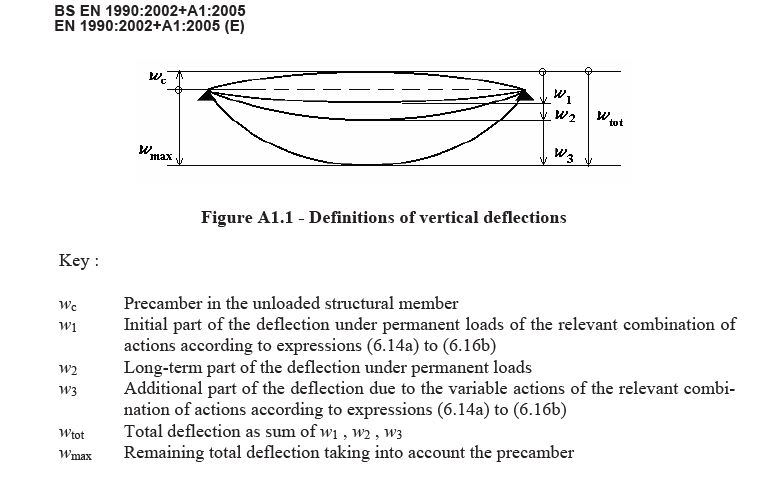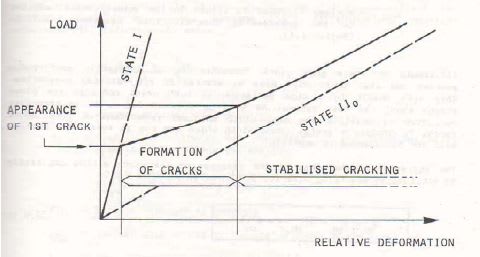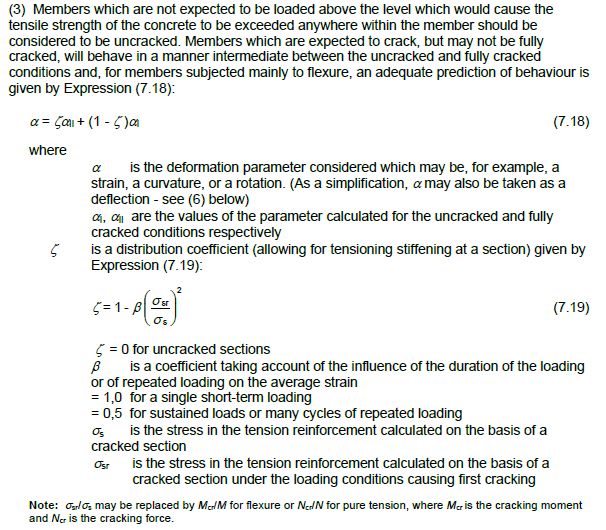hardbutmild
Structural
- Aug 10, 2019
- 294
Hello everyone,
I have a question regarding deflections of floors (or beams) in eurocode, but a general discussion on the philosophy of deflection control is something that would be great so please comment even if you're not familiar with eurocode.
As far as I understand, the code wants me to check the long-term deflections for quasipermanent (QP) load (equivalent to "sustained" load in ACI if I understand ACI correctly) and limit it to L/250.
It also requires that you limit additional deflection to L/300 (EDIT: this seems very large, especially compared to the first limit), but I don't know if I should always check this, for what combination and how to take long-term effects for that?
It makes sense to me to check it for variable loads only (that is additional load), but some of it is supposed to be sustained for a long period of time (30% for residential and office, 80% for a library...). Do I add long term effects for that part of the load or not? I would check 30% of variable load for long-term and the remaining 70% of the load for instantaneous to limit the additional deflection and avoid potential damage to the nonstructural elements.
There is also a problem with the first check (take QP load and limit the long-term deflection) because the additional "not-sustained" part of the load could crack the element more (load history is important) leading to a larger deflection under QP. Some engineers also check for characteristic load (full permanent and variable without load factors), but everything is short-term. I do not understand the point of this check.
I am aware that anything we calculate is very far from realtiy and generally simpler = better, but I feel like a discussion would be valuable, just to hear what others are doing and what your thoughts are.
There is also a question of: "Should we completely avoid nonstructural damage?". This may lead to thick floors, but lowers the cost of maintenance. It is of course easy to say "discuss it with the person paying for the project". Unfortunately they are usually people who do not intend to use the structure and only want to build cheap and sell expensive (at least where I'm from).
This is more intended as a discussion to see how others go about the problems that are not as exact as for example capacity check.
I have a question regarding deflections of floors (or beams) in eurocode, but a general discussion on the philosophy of deflection control is something that would be great so please comment even if you're not familiar with eurocode.
As far as I understand, the code wants me to check the long-term deflections for quasipermanent (QP) load (equivalent to "sustained" load in ACI if I understand ACI correctly) and limit it to L/250.
It also requires that you limit additional deflection to L/300 (EDIT: this seems very large, especially compared to the first limit), but I don't know if I should always check this, for what combination and how to take long-term effects for that?
It makes sense to me to check it for variable loads only (that is additional load), but some of it is supposed to be sustained for a long period of time (30% for residential and office, 80% for a library...). Do I add long term effects for that part of the load or not? I would check 30% of variable load for long-term and the remaining 70% of the load for instantaneous to limit the additional deflection and avoid potential damage to the nonstructural elements.
There is also a problem with the first check (take QP load and limit the long-term deflection) because the additional "not-sustained" part of the load could crack the element more (load history is important) leading to a larger deflection under QP. Some engineers also check for characteristic load (full permanent and variable without load factors), but everything is short-term. I do not understand the point of this check.
I am aware that anything we calculate is very far from realtiy and generally simpler = better, but I feel like a discussion would be valuable, just to hear what others are doing and what your thoughts are.
There is also a question of: "Should we completely avoid nonstructural damage?". This may lead to thick floors, but lowers the cost of maintenance. It is of course easy to say "discuss it with the person paying for the project". Unfortunately they are usually people who do not intend to use the structure and only want to build cheap and sell expensive (at least where I'm from).
This is more intended as a discussion to see how others go about the problems that are not as exact as for example capacity check.



